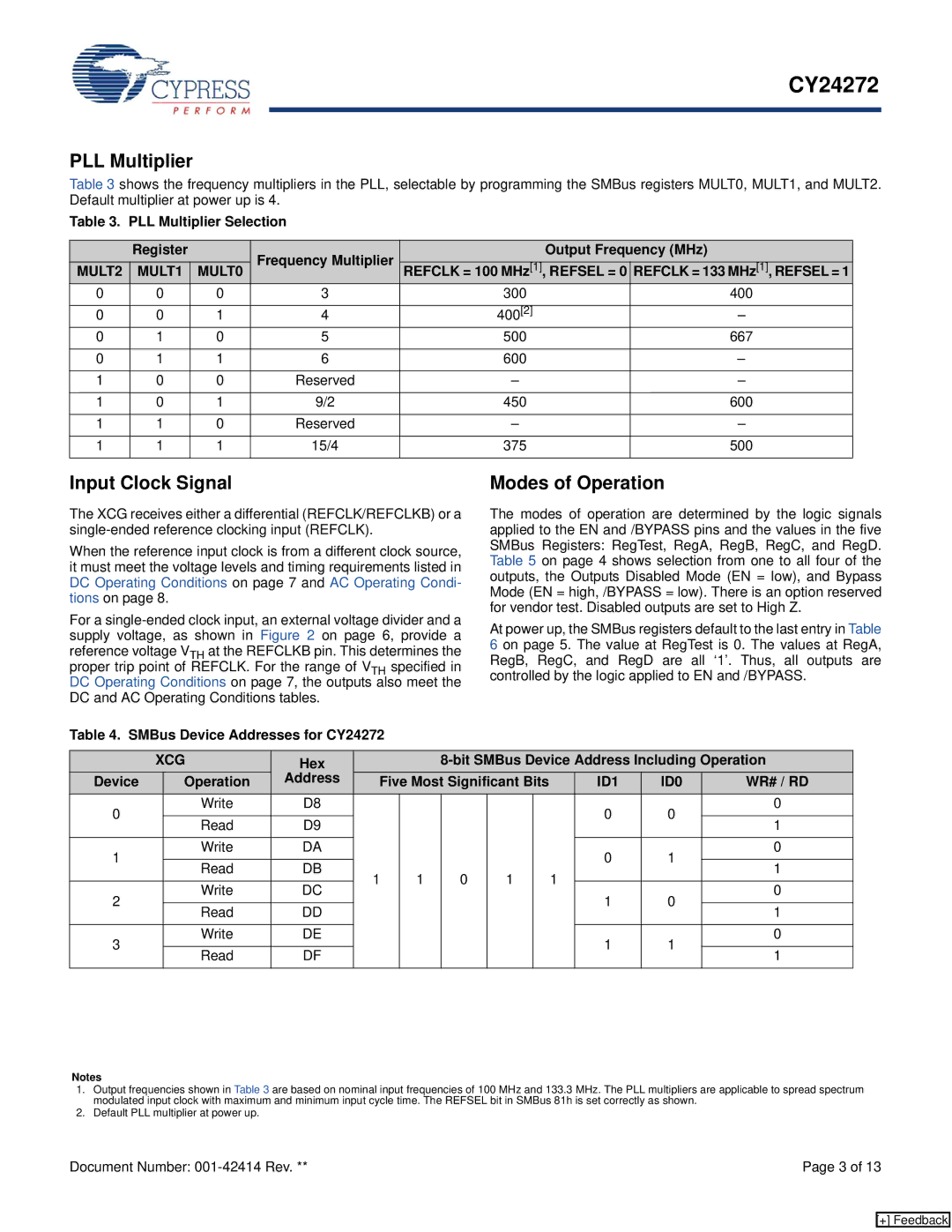
CY24272
PLL Multiplier
Table 3 shows the frequency multipliers in the PLL, selectable by programming the SMBus registers MULT0, MULT1, and MULT2. Default multiplier at power up is 4.
Table 3. PLL Multiplier Selection
| Register |
| Frequency Multiplier |
| Output Frequency (MHz) | |
MULT2 | MULT1 | MULT0 | REFCLK = 100 MHz[1], REFSEL = 0 | REFCLK = 133 MHz[1], REFSEL = 1 | ||
0 | 0 | 0 | 3 | 300 |
| 400 |
|
|
|
|
|
|
|
0 | 0 | 1 | 4 | 400[2] |
| – |
0 | 1 | 0 | 5 | 500 |
| 667 |
|
|
|
|
|
|
|
0 | 1 | 1 | 6 | 600 |
| – |
|
|
|
|
|
|
|
1 | 0 | 0 | Reserved | – |
| – |
|
|
|
|
|
|
|
1 | 0 | 1 | 9/2 | 450 |
| 600 |
|
|
|
|
|
|
|
1 | 1 | 0 | Reserved | – |
| – |
|
|
|
|
|
|
|
1 | 1 | 1 | 15/4 | 375 |
| 500 |
|
|
|
|
|
|
|
Input Clock Signal
The XCG receives either a differential (REFCLK/REFCLKB) or a
When the reference input clock is from a different clock source, it must meet the voltage levels and timing requirements listed in DC Operating Conditions on page 7 and AC Operating Condi- tions on page 8.
For a
Table 4. SMBus Device Addresses for CY24272
Modes of Operation
The modes of operation are determined by the logic signals applied to the EN and /BYPASS pins and the values in the five SMBus Registers: RegTest, RegA, RegB, RegC, and RegD. Table 5 on page 4 shows selection from one to all four of the outputs, the Outputs Disabled Mode (EN = low), and Bypass Mode (EN = high, /BYPASS = low). There is an option reserved for vendor test. Disabled outputs are set to High Z.
At power up, the SMBus registers default to the last entry in Table 6 on page 5. The value at RegTest is 0. The values at RegA, RegB, RegC, and RegD are all ‘1’. Thus, all outputs are controlled by the logic applied to EN and /BYPASS.
| XCG | Hex |
|
| |||||||||
Device |
| Operation | Address | Five Most Significant Bits |
| ID1 | ID0 | WR# / RD | |||||
0 |
| Write | D8 |
|
|
|
|
|
|
| 0 | 0 | 0 |
|
|
|
|
|
|
|
|
|
|
| |||
| Read | D9 |
|
|
|
|
|
|
| 1 | |||
|
|
|
|
|
|
|
|
|
|
| |||
|
|
|
|
|
|
|
|
|
|
|
|
|
|
1 |
| Write | DA |
|
|
|
|
|
|
| 0 | 1 | 0 |
|
|
|
|
|
|
|
|
|
|
| |||
| Read | DB | 1 | 1 |
| 0 | 1 |
| 1 | 1 | |||
|
|
|
|
|
| ||||||||
|
|
|
|
|
|
|
|
| |||||
2 |
| Write | DC |
|
| 1 | 0 | 0 | |||||
|
|
|
|
|
|
|
| ||||||
|
|
|
|
|
|
|
|
|
|
| |||
| Read | DD |
|
|
|
|
|
|
| 1 | |||
|
|
|
|
|
|
|
|
|
|
| |||
|
|
|
|
|
|
|
|
|
|
|
|
|
|
3 |
| Write | DE |
|
|
|
|
|
|
| 1 | 1 | 0 |
|
|
|
|
|
|
|
|
|
|
| |||
| Read | DF |
|
|
|
|
|
|
| 1 | |||
|
|
|
|
|
|
|
|
|
|
| |||
|
|
|
|
|
|
|
|
|
|
|
|
|
|
Notes
1.Output frequencies shown in Table 3 are based on nominal input frequencies of 100 MHz and 133.3 MHz. The PLL multipliers are applicable to spread spectrum modulated input clock with maximum and minimum input cycle time. The REFSEL bit in SMBus 81h is set correctly as shown.
2.Default PLL multiplier at power up.
Document Number: | Page 3 of 13 |
[+] Feedback
